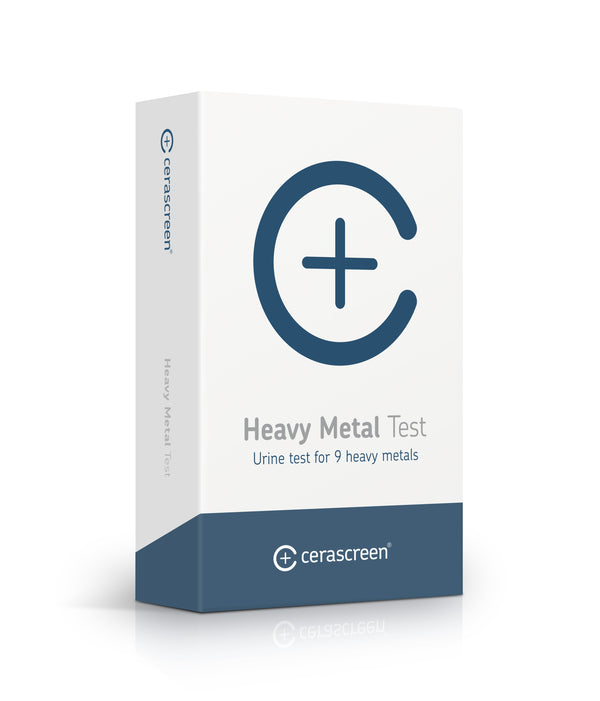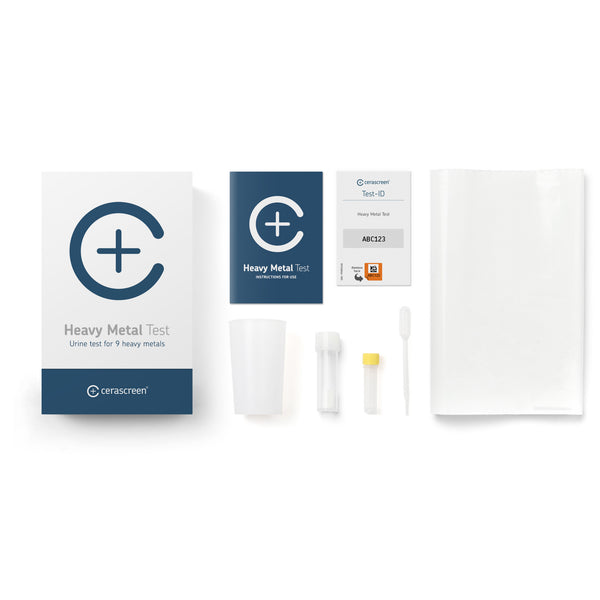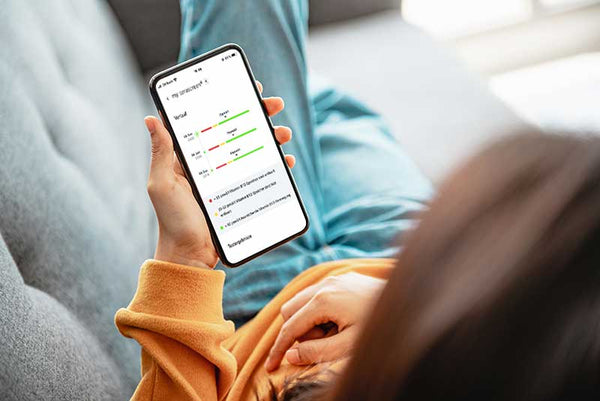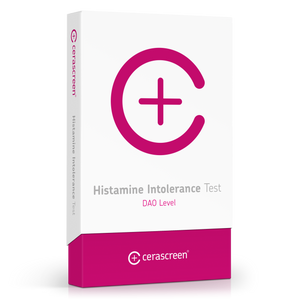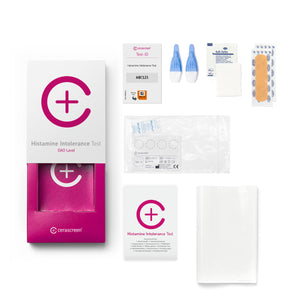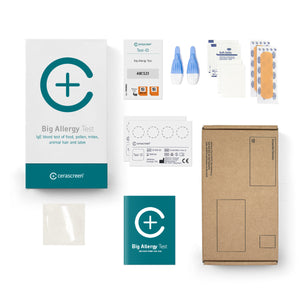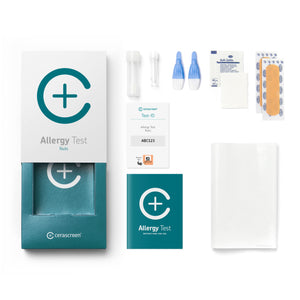product_id = 5090139373627variant_id = template_name =
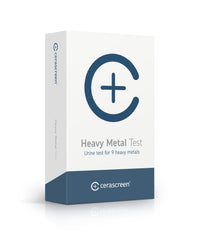
Heavy Metal Test
About the test
With the cerascreen® Heavy Metal Test, you can determine the concentration of various heavy metals in your urine such as aluminium, arsenic, lead, cadmium, chromium, cobalt, nickel, mercury and zinc. By doing this, you can check whether you are at risk of heavy metal poisoning – and you can also identify and avoid specific sources of pollutants in your everyday life.
Heavy metals can accumulate in the body over time and in the long term lead to damage in your organs, nervous system and blood formation, for instance. Drinking water from old pipes and contaminated food or household objects – for example – can cause heavy metal poisoning.
Heavy Metal Test
- Take your urine sample at home – conveniently and discreetly
- Receive a state-of-the-art laboratory analysis
- Benefit from specific recommendations on how to prevent heavy metal poisoning
- Receive your result within 5 to 7 working days after sample’s arrival in the laboratory
Benefits of the Heavy Metal Test
From arsenic in rice and lead in old water pipes to mercury vapour from old-fashioned thermometers – heavy metals can enter our bodies in various ways. If a test reveals high exposure levels, you can recognise and eliminate the sources of pollutants in your everyday life.
The cerascreen® Heavy Metal Test is carried out in our modern medical laboratory. The good news is that you do not have to wait in your doctor's surgery. You take your sample discreetly and conveniently at home and send it back to us by post.
Benefit from our expertise: cerascreen® is the market leader for medical sampling and submission kits in Europe, with eight years of experience in test development and analysis. We have developed more than 50 approved send-in test kits (medical devices), evaluated 250,000 samples and serve 19 countries in Europe – and now the United States.

Result of the Heavy Metal Test
As soon as your sample has been analysed, you will receive your results report via the My cerascreen® app or your user account on our website. You can easily view the report on your smartphone, tablet or computer and print it out, if required.
Learn through our laboratory analysis whether the heavy metal levels in your urine are within the usual and recommended range. Learn how to identify sources of pollution and reduce heavy metal exposure in everyday life through easy-to-use recommendations. Learn more about the individual heavy metals and their effect on the environment and body in our health information.
Frequently asked questions about Heavy Metal Test
Why take the Heavy Metal Test?
Toxic heavy metals such as arsenic, lead, cadmium and mercury enter the environment in various ways, into the air we breathe, as well as into soils and plants. Heavy metals can accumulate in your body when you consume contaminated food or drinking water through household objects. In the long run, a build-up of heavy metals can lead to chronic poisoning and damage your nerve cells, liver and kidneys, among other things.
If you know which heavy metals you are exposed to, you can specifically look out for possible sources of pollutants – and avoid them in the future.
How does the test work?
The Heavy Metal Test is a simple urine test. Collect a small amount of urine with a collection cup and a transfer pipette. You then send the urine sample in a collection tube to our certified specialist laboratory. A few days later, you will receive a notification that your results report is ready by email – you’ll find your personal report by logging in to your account on My cerascreen.
What will the results tell me?
In the results report, you will find the concentration of the following metals measured in your urine: aluminium, arsenic, lead, cadmium, chromium, cobalt, nickel, mercury and zinc. For comparison, you will also receive the recommended reference values, which your values should not exceed. In the case of copper and zinc, there is also a recommended minimum value, as the body needs these two metals.
For some heavy metals, it is enough to measure their concentration in your urine. Others are measured per gramme of creatinine in your urine – so, the measurement takes into account the concentration of your urine so that it does not affect the results.
The measurements you receive give you a great indication of your current exposure to heavy metals.
How long does the analysis take in the laboratory?
Once your sample has arrived at the laboratory, it will be analyzed there by specialists. How long the analysis takes depends on the exact measuring method and the processes in the laboratory.
If the sample is sent on the correct days (Sunday to Tuesday), this makes it easier for the laboratory to adhere to the times.
For the Heavy Metal Test, the laboratory analysis is usually completed within 11 working days after the sample is received in the laboratory.
Which recommendations will I receive?
If the Heavy Metal Test reveals excessive exposure to heavy metals, you should visit your doctor as soon as possible. Doctors can advise you and, in severe cases, remove the metals with chelation treatment.
If the levels of certain heavy metals are slightly higher than normal, you should do anything you can to avoid the source of the pollutants. This then means, for example, avoiding fish if a lot of mercury was found in your body, paying attention to how much rice you eat if you had high arsenic levels, or skipping zinc supplements if your zinc levels were significantly higher than normal.
What are heavy metals?
Heavy metals are metals that can be toxic to humans in larger quantities. These include, above all, lead, cadmium, chromium, cobalt, nickel, mercury and zinc.
When talking about heavy metals, two other metals are often mentioned that are not heavy metals but can also be harmful: aluminium, which is a light metal, and arsenic, which is a semimetal.
Heavy metals enter the air we breathe mainly through emissions from factories and road traffic. From there, they settle in the air we breathe and also enter our food via soils and plants.
What are the symptoms of heavy metal poisoning?
In your own home, for example, broken residues of old mercury thermometers and ceramics with a lead glaze can lead to chronic heavy metal exposure. In the long run, such increased heavy metal exposure could also affect your health.
Symptoms of chronic heavy metal poisoning depend on the way heavy metals enter the body. Mostly, this happens via your skin, respiratory tract or gastrointestinal tract. Possible symptoms are:
Diarrhoea, vomiting and nausea
Stomach pain, headaches and aching limbs
Sleeping problems and a feeling of weakness
Skin changes
Symptoms of paralysis
Acute heavy metal poisoning is rare today. Cases are mostly the result of accidents, especially in the metal industry.
How do I reduce exposure to heavy metals?
In order to ingest as few toxic heavy metals as possible in your everyday life, you should be aware of the typical sources of pollutants.
There are a number of foods that are often contaminated with heavy metals:
- Arsenic in rice and rice products
- Mercury in large saltwater fish
- Lead in leafy vegetables and game
- Cadmium in wild mushrooms and beef or pork liver
Other sources of pollutants in your daily life include:
- Lead pipes in old buildings
- Lead-glazed ceramics (often bought while travelling)
- Broken old mercury thermometers
- Old home remedy ointments and contaminated Ayurvedic supplements from Asia
When and how do you get rid of heavy metals in your body?
In cases of severe heavy metal poisoning, doctors use chelation treatment. They administer chelate complexes; these substances bind heavy metals in your body. Your body can then excrete the metal and chelate compound relatively easily. However, important trace element such as zinc is also flushed out of the body. Doctors therefore monitor these mineral levels and prescribe dietary supplements, if necessary.
If there is only mild poisoning or chronic heavy metal exposure, treatment usually involves avoiding the sources of the pollutants, so that your body can gradually eliminate the metals itself. In some cases, your body needs many years to get rid of heavy metals once they have been stored there – this can only succeed if more pollutants do not enter your body and accumulate there on a regular basis.
Who should NOT take the Heavy Metal Test?
The Heavy Metal Test is not or only partially suitable for certain groups of people:
People with infectious diseases, like hepatitis and HIV, may not use the Heavy Metal Test.
People with haemophilia should not take the test.
Pregnant and breastfeeding women should only take the Heavy Metal Test under medical supervision. The given reference ranges and recommendations do not apply to people in this group; consult your medical professional for advice concerning your test results.
The Heavy Metal Test is not intended for children under 18 years of age.
The test is not intended for diagnosing illnesses or disease. For example, if you suffer from depression or are in extreme physical pain, consult a doctor.
Why are children under 18 not allowed to take the test?
Our tests are not suitable for underage children and adolescents under the age of 18. Under 18s cannot activate the tests online and therefore cannot receive a test result. We ask that you do not administer the tests to your children either.
Children and adolescents need much closer supervision and counselling regarding medical tests and their interpretation. Testing with lancets and chemicals is not without risk and would need to be closely supervised by guardians. In addition, the reference values we give are always based on adult data. In the case of children, the risk of misinterpreting the results would be very high.
We want to fulfil our responsibility as a provider of medical products and ensure that children and adolescents are not unsettled by measurement results that are difficult for them to interpret. Since we cannot control whether the minors' legal guardians actually consent to the test being carried out and supervise them, we exclude tests for under 18s altogether.
If you are under 18 and have purchased a test, please contact our customer support.
Why does it take up to a week for the sample to reach the lab?
Please bear in mind that your results will not be analyzed in the UK but in Germany. For that reason, it can take up to a week for the sample to arrive at the lab. This does not affect the stability of the samples, as the method we are using is optimized for long transports.
Initially, your sample is sent to our collection center in the UK. From there, it is shipped to our central sample sorting facility in Germany, which then distributes samples to our partner laboratories. Once your sample is analyzed there, you will receive a notification and can access your result online.
Please check your mailbox regularly. We will notify you as soon as your sample is sent, arrives, or is analyzed.
Why does the test have an expiration date?
The cerascreen® test kits are CE-marked medical devices, which in turn include other certified medical components such as lancets, patches, and alcohol swabs used in blood tests.
Like most medical devices, these components have an expiration date to ensure that they remain safe and effective. Many of our sample carriers – such as dried blood cards or sample tubes – are chemically treated to keep your sample stable and analyzable in our laboratory. Over time, environmental factors can affect this treatment and compromise accuracy.
Our sterile, single-use lancets also carry an expiration date to guarantee sterility and safe use up to that time.
This is how it works
1. Test at home
Your test kit contains everything you need to take a small urine sample. Then send the sample back to us free of charge in the enclosed return envelope.
2. View results online
After the evaluation in the medical specialist laboratory, you will have online access to your personal result report.
3. Act
Your access to the test results and the evidence-based findings and tips to improve your health: the my cerascreen® user profile on our website or our app.





